Hood College Car Parking System Documentation: Analysis and Design
VerifiedAdded on 2020/04/15
|12
|1183
|46
Report
AI Summary
This documentation provides a comprehensive overview of a car parking system, focusing on its current state at Hood College. The report begins with a summary of the current system, highlighting the problems faced by staff, students, and visitors in finding parking spaces. It then delves into the background, objectives, and functionality of the existing system, which primarily focuses on access control using gate passes. The documentation details the current methods, procedures, and equipment used, including gate passes, sensors, barriers, and cameras. It also analyzes the input and output of the system, including data flow diagrams and system interfaces. Furthermore, the report identifies the deficiencies of the current system, such as the lack of a system to manage vehicles within the car parks. It outlines the functional requirements of an improved system, including the ability to identify free parking spaces and user-friendliness. Finally, the document presents a use case diagram of the proposed system and includes a glossary and data flow diagrams to illustrate the system's processes. The report provides references to related research papers and articles.

Car Parking System Documentation
Author:
Document Date: 16/11/2017
Version 1.0
Table of Contents
1
Author:
Document Date: 16/11/2017
Version 1.0
Table of Contents
1
Paraphrase This Document
Need a fresh take? Get an instant paraphrase of this document with our AI Paraphraser
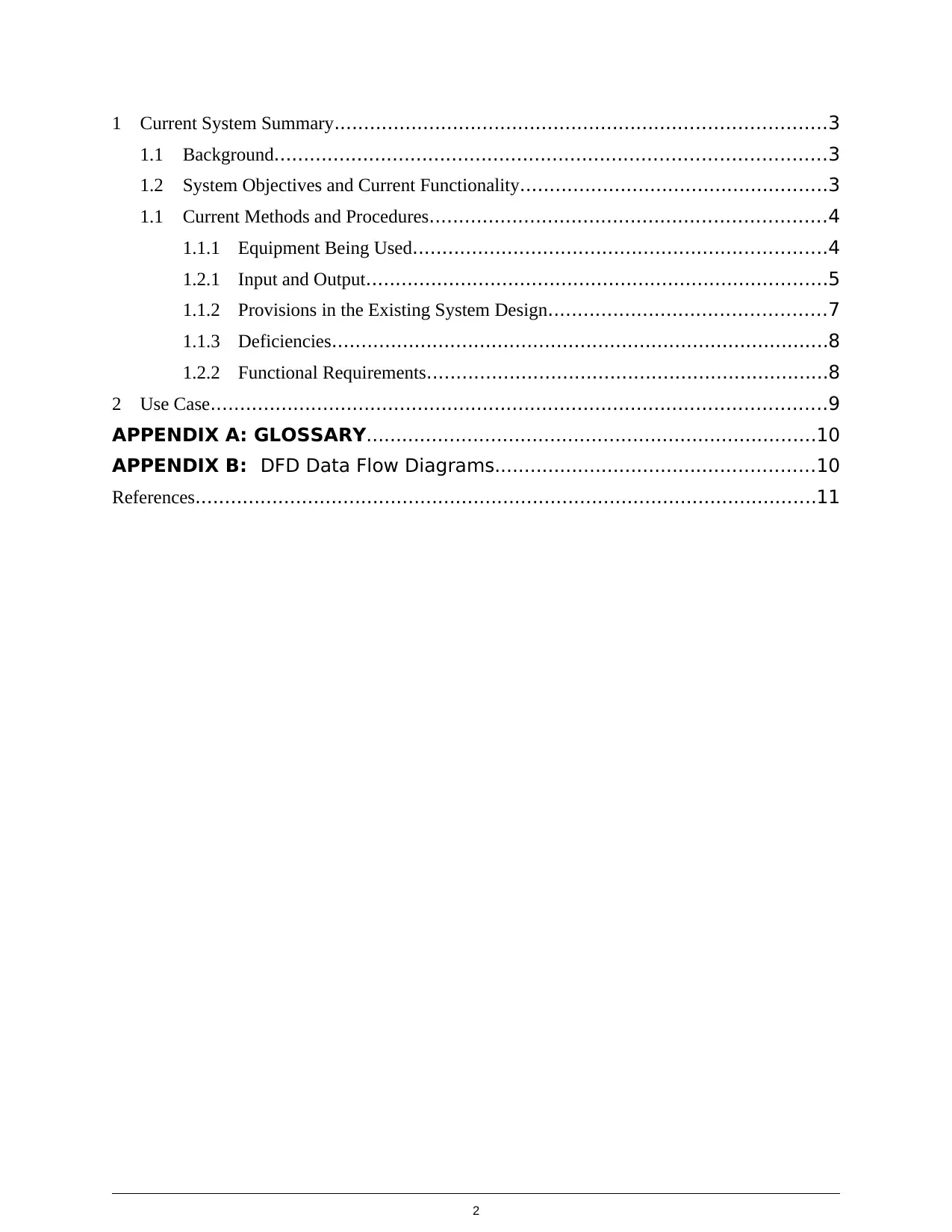
1 Current System Summary...................................................................................3
1.1 Background.............................................................................................3
1.2 System Objectives and Current Functionality....................................................3
1.1 Current Methods and Procedures...................................................................4
1.1.1 Equipment Being Used......................................................................4
1.2.1 Input and Output..............................................................................5
1.1.2 Provisions in the Existing System Design...............................................7
1.1.3 Deficiencies....................................................................................8
1.2.2 Functional Requirements....................................................................8
2 Use Case........................................................................................................9
APPENDIX A: GLOSSARY............................................................................10
APPENDIX B: DFD Data Flow Diagrams......................................................10
References.........................................................................................................11
2
1.1 Background.............................................................................................3
1.2 System Objectives and Current Functionality....................................................3
1.1 Current Methods and Procedures...................................................................4
1.1.1 Equipment Being Used......................................................................4
1.2.1 Input and Output..............................................................................5
1.1.2 Provisions in the Existing System Design...............................................7
1.1.3 Deficiencies....................................................................................8
1.2.2 Functional Requirements....................................................................8
2 Use Case........................................................................................................9
APPENDIX A: GLOSSARY............................................................................10
APPENDIX B: DFD Data Flow Diagrams......................................................10
References.........................................................................................................11
2
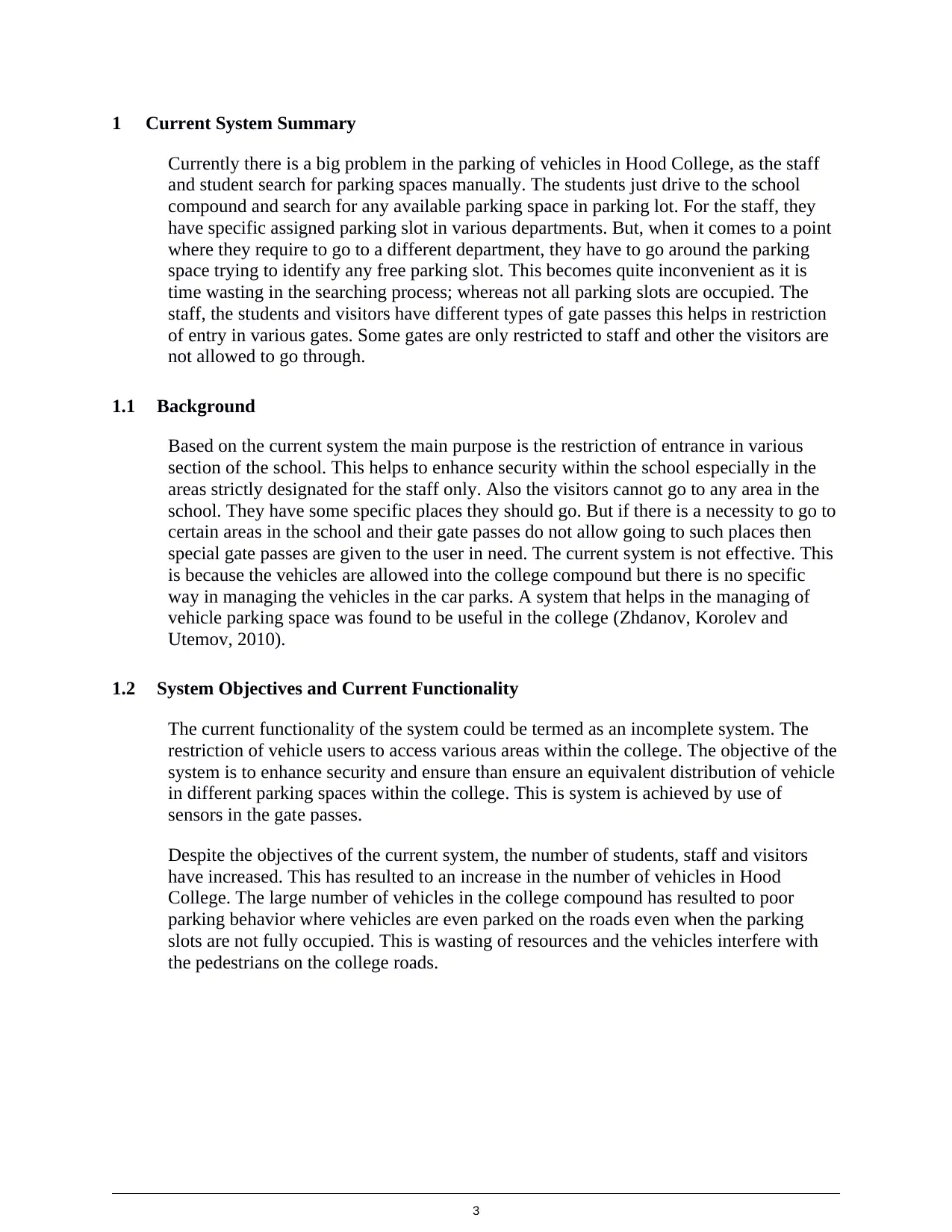
1 Current System Summary
Currently there is a big problem in the parking of vehicles in Hood College, as the staff
and student search for parking spaces manually. The students just drive to the school
compound and search for any available parking space in parking lot. For the staff, they
have specific assigned parking slot in various departments. But, when it comes to a point
where they require to go to a different department, they have to go around the parking
space trying to identify any free parking slot. This becomes quite inconvenient as it is
time wasting in the searching process; whereas not all parking slots are occupied. The
staff, the students and visitors have different types of gate passes this helps in restriction
of entry in various gates. Some gates are only restricted to staff and other the visitors are
not allowed to go through.
1.1 Background
Based on the current system the main purpose is the restriction of entrance in various
section of the school. This helps to enhance security within the school especially in the
areas strictly designated for the staff only. Also the visitors cannot go to any area in the
school. They have some specific places they should go. But if there is a necessity to go to
certain areas in the school and their gate passes do not allow going to such places then
special gate passes are given to the user in need. The current system is not effective. This
is because the vehicles are allowed into the college compound but there is no specific
way in managing the vehicles in the car parks. A system that helps in the managing of
vehicle parking space was found to be useful in the college (Zhdanov, Korolev and
Utemov, 2010).
1.2 System Objectives and Current Functionality
The current functionality of the system could be termed as an incomplete system. The
restriction of vehicle users to access various areas within the college. The objective of the
system is to enhance security and ensure than ensure an equivalent distribution of vehicle
in different parking spaces within the college. This is system is achieved by use of
sensors in the gate passes.
Despite the objectives of the current system, the number of students, staff and visitors
have increased. This has resulted to an increase in the number of vehicles in Hood
College. The large number of vehicles in the college compound has resulted to poor
parking behavior where vehicles are even parked on the roads even when the parking
slots are not fully occupied. This is wasting of resources and the vehicles interfere with
the pedestrians on the college roads.
3
Currently there is a big problem in the parking of vehicles in Hood College, as the staff
and student search for parking spaces manually. The students just drive to the school
compound and search for any available parking space in parking lot. For the staff, they
have specific assigned parking slot in various departments. But, when it comes to a point
where they require to go to a different department, they have to go around the parking
space trying to identify any free parking slot. This becomes quite inconvenient as it is
time wasting in the searching process; whereas not all parking slots are occupied. The
staff, the students and visitors have different types of gate passes this helps in restriction
of entry in various gates. Some gates are only restricted to staff and other the visitors are
not allowed to go through.
1.1 Background
Based on the current system the main purpose is the restriction of entrance in various
section of the school. This helps to enhance security within the school especially in the
areas strictly designated for the staff only. Also the visitors cannot go to any area in the
school. They have some specific places they should go. But if there is a necessity to go to
certain areas in the school and their gate passes do not allow going to such places then
special gate passes are given to the user in need. The current system is not effective. This
is because the vehicles are allowed into the college compound but there is no specific
way in managing the vehicles in the car parks. A system that helps in the managing of
vehicle parking space was found to be useful in the college (Zhdanov, Korolev and
Utemov, 2010).
1.2 System Objectives and Current Functionality
The current functionality of the system could be termed as an incomplete system. The
restriction of vehicle users to access various areas within the college. The objective of the
system is to enhance security and ensure than ensure an equivalent distribution of vehicle
in different parking spaces within the college. This is system is achieved by use of
sensors in the gate passes.
Despite the objectives of the current system, the number of students, staff and visitors
have increased. This has resulted to an increase in the number of vehicles in Hood
College. The large number of vehicles in the college compound has resulted to poor
parking behavior where vehicles are even parked on the roads even when the parking
slots are not fully occupied. This is wasting of resources and the vehicles interfere with
the pedestrians on the college roads.
3
⊘ This is a preview!⊘
Do you want full access?
Subscribe today to unlock all pages.

Trusted by 1+ million students worldwide
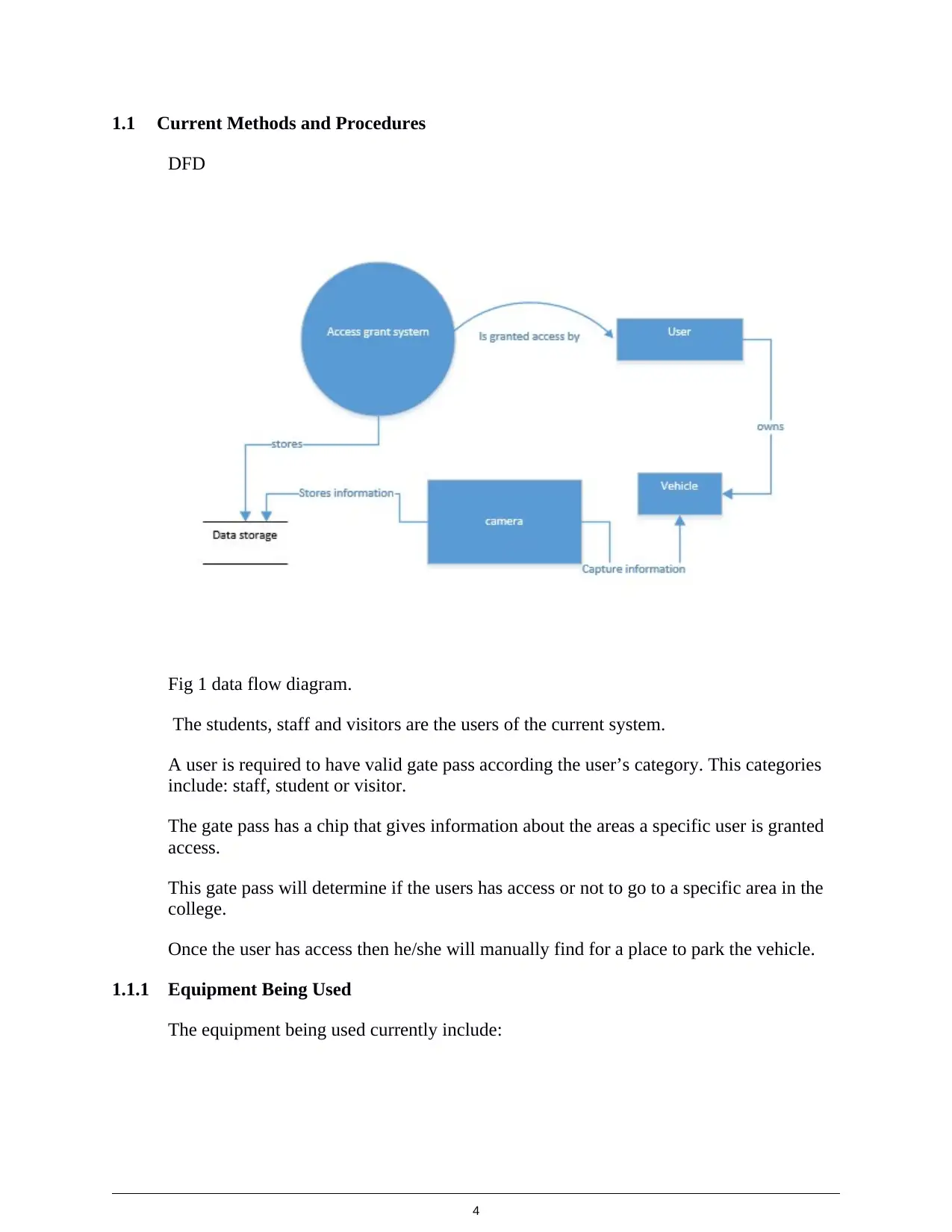
1.1 Current Methods and Procedures
DFD
Fig 1 data flow diagram.
The students, staff and visitors are the users of the current system.
A user is required to have valid gate pass according the user’s category. This categories
include: staff, student or visitor.
The gate pass has a chip that gives information about the areas a specific user is granted
access.
This gate pass will determine if the users has access or not to go to a specific area in the
college.
Once the user has access then he/she will manually find for a place to park the vehicle.
1.1.1 Equipment Being Used
The equipment being used currently include:
4
DFD
Fig 1 data flow diagram.
The students, staff and visitors are the users of the current system.
A user is required to have valid gate pass according the user’s category. This categories
include: staff, student or visitor.
The gate pass has a chip that gives information about the areas a specific user is granted
access.
This gate pass will determine if the users has access or not to go to a specific area in the
college.
Once the user has access then he/she will manually find for a place to park the vehicle.
1.1.1 Equipment Being Used
The equipment being used currently include:
4
Paraphrase This Document
Need a fresh take? Get an instant paraphrase of this document with our AI Paraphraser
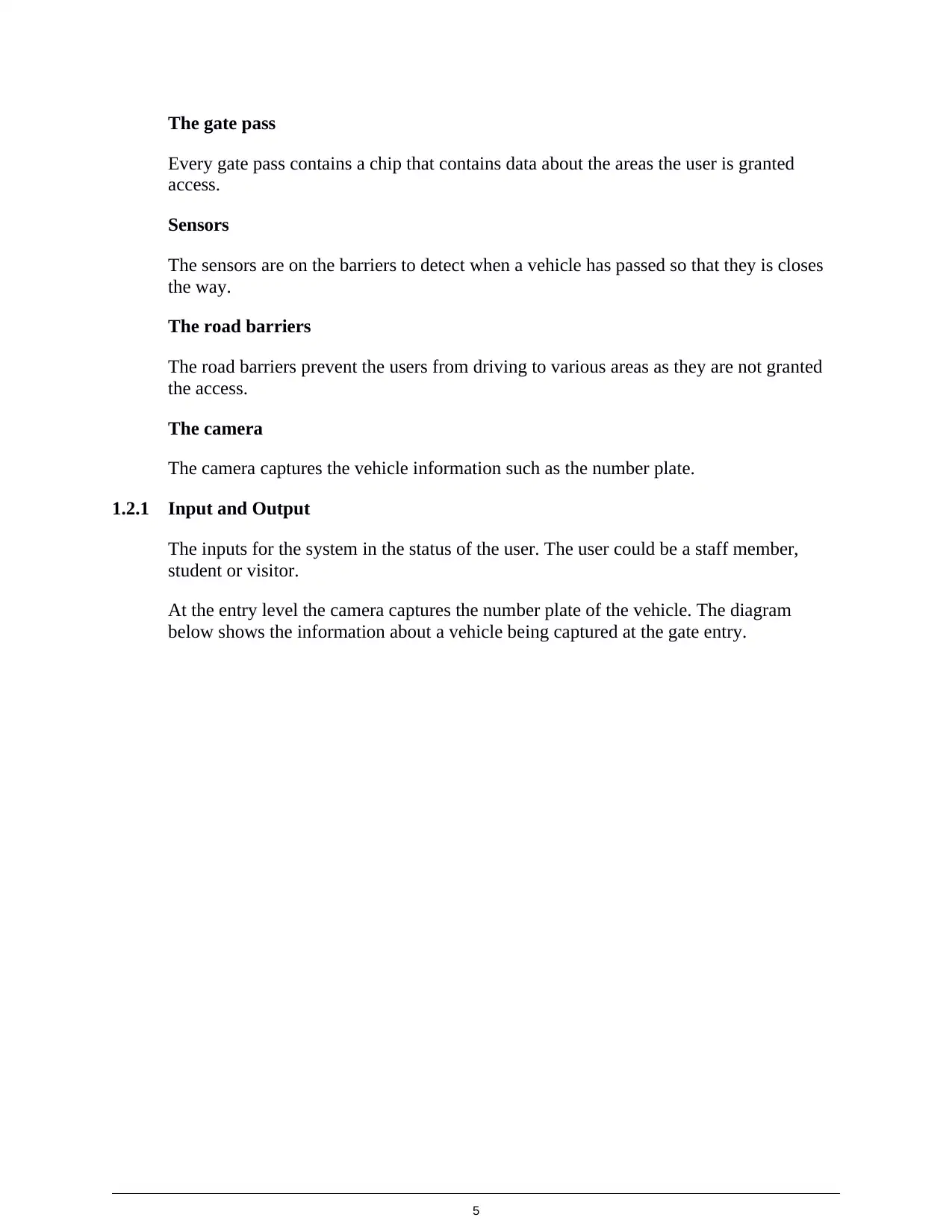
The gate pass
Every gate pass contains a chip that contains data about the areas the user is granted
access.
Sensors
The sensors are on the barriers to detect when a vehicle has passed so that they is closes
the way.
The road barriers
The road barriers prevent the users from driving to various areas as they are not granted
the access.
The camera
The camera captures the vehicle information such as the number plate.
1.2.1 Input and Output
The inputs for the system in the status of the user. The user could be a staff member,
student or visitor.
At the entry level the camera captures the number plate of the vehicle. The diagram
below shows the information about a vehicle being captured at the gate entry.
5
Every gate pass contains a chip that contains data about the areas the user is granted
access.
Sensors
The sensors are on the barriers to detect when a vehicle has passed so that they is closes
the way.
The road barriers
The road barriers prevent the users from driving to various areas as they are not granted
the access.
The camera
The camera captures the vehicle information such as the number plate.
1.2.1 Input and Output
The inputs for the system in the status of the user. The user could be a staff member,
student or visitor.
At the entry level the camera captures the number plate of the vehicle. The diagram
below shows the information about a vehicle being captured at the gate entry.
5
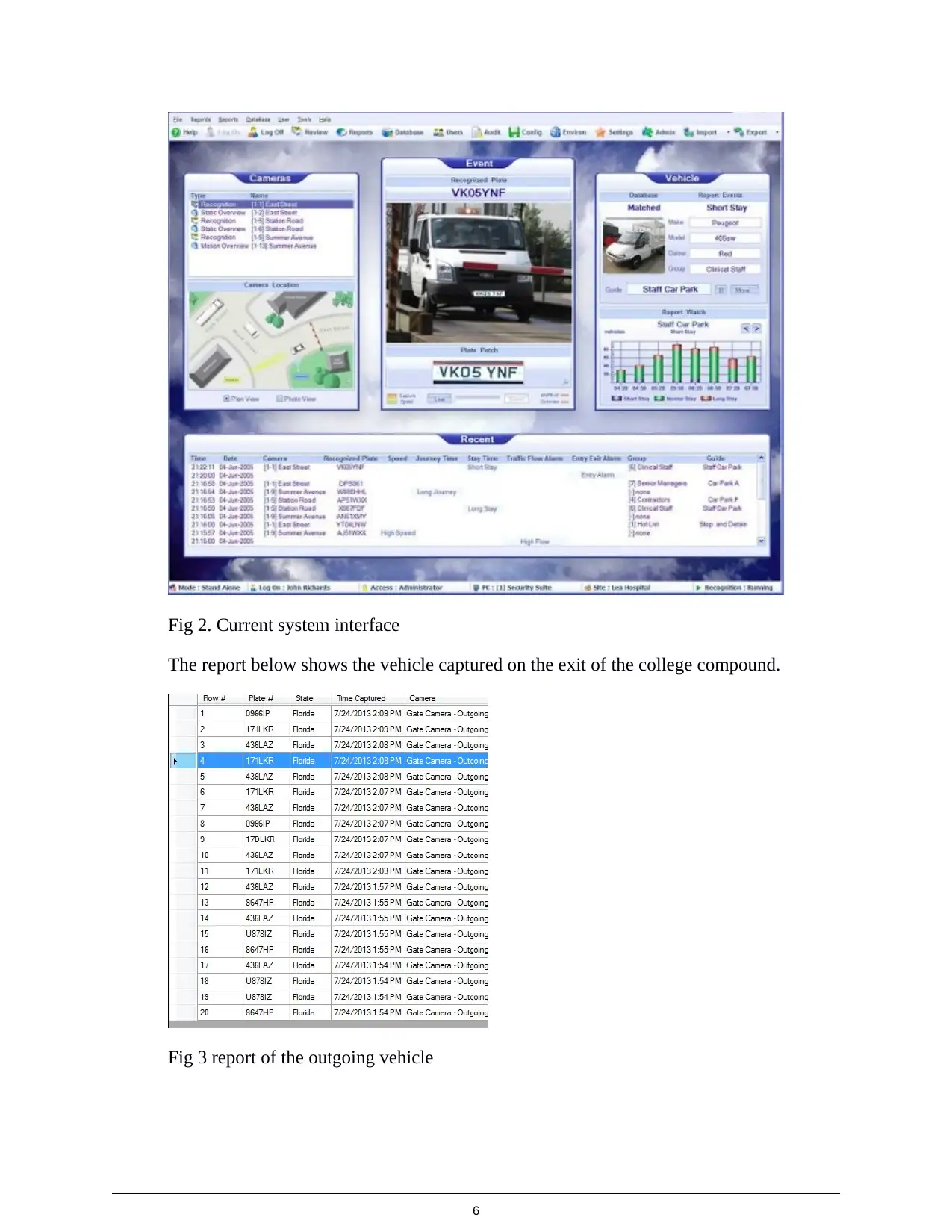
Fig 2. Current system interface
The report below shows the vehicle captured on the exit of the college compound.
Fig 3 report of the outgoing vehicle
6
The report below shows the vehicle captured on the exit of the college compound.
Fig 3 report of the outgoing vehicle
6
⊘ This is a preview!⊘
Do you want full access?
Subscribe today to unlock all pages.

Trusted by 1+ million students worldwide
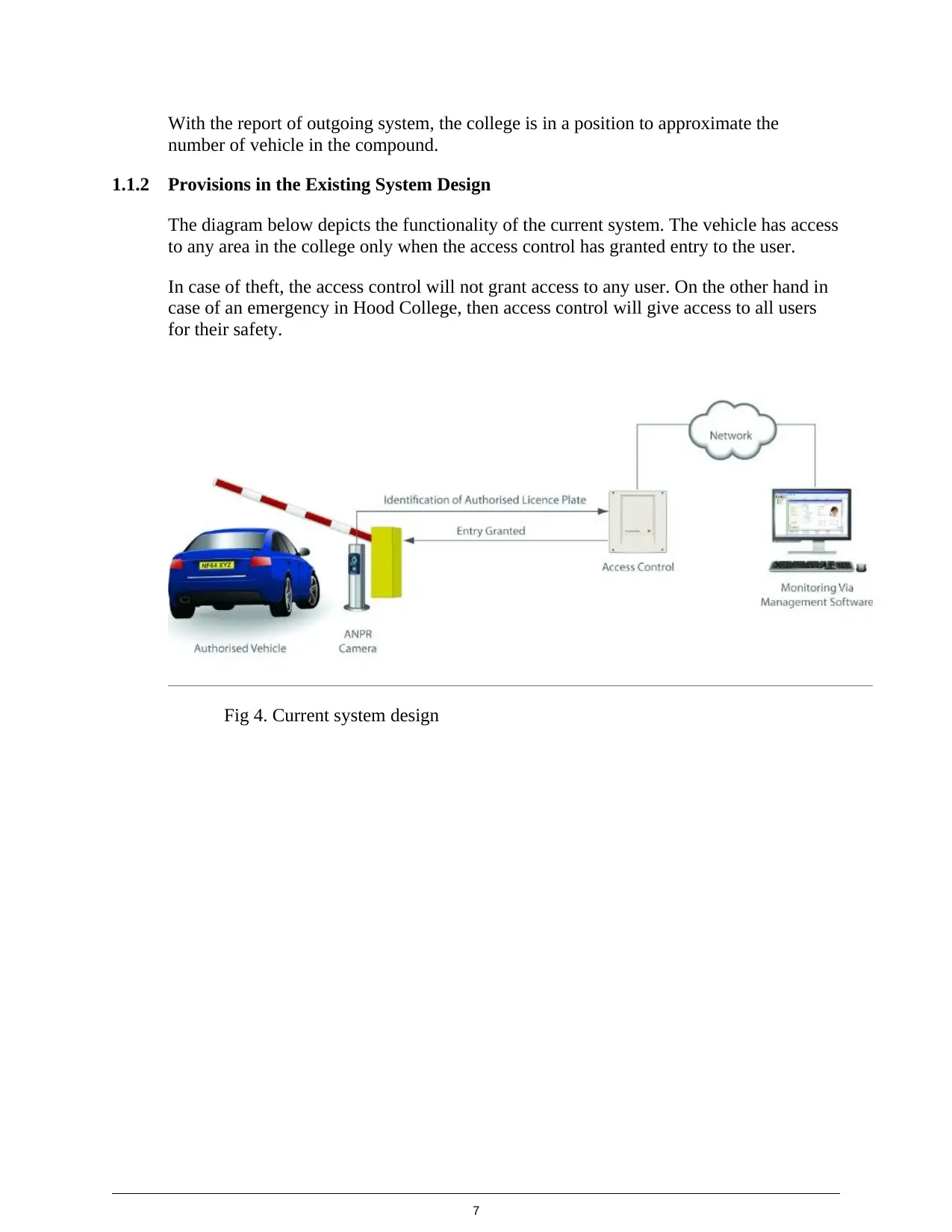
With the report of outgoing system, the college is in a position to approximate the
number of vehicle in the compound.
1.1.2 Provisions in the Existing System Design
The diagram below depicts the functionality of the current system. The vehicle has access
to any area in the college only when the access control has granted entry to the user.
In case of theft, the access control will not grant access to any user. On the other hand in
case of an emergency in Hood College, then access control will give access to all users
for their safety.
Fig 4. Current system design
7
number of vehicle in the compound.
1.1.2 Provisions in the Existing System Design
The diagram below depicts the functionality of the current system. The vehicle has access
to any area in the college only when the access control has granted entry to the user.
In case of theft, the access control will not grant access to any user. On the other hand in
case of an emergency in Hood College, then access control will give access to all users
for their safety.
Fig 4. Current system design
7
Paraphrase This Document
Need a fresh take? Get an instant paraphrase of this document with our AI Paraphraser
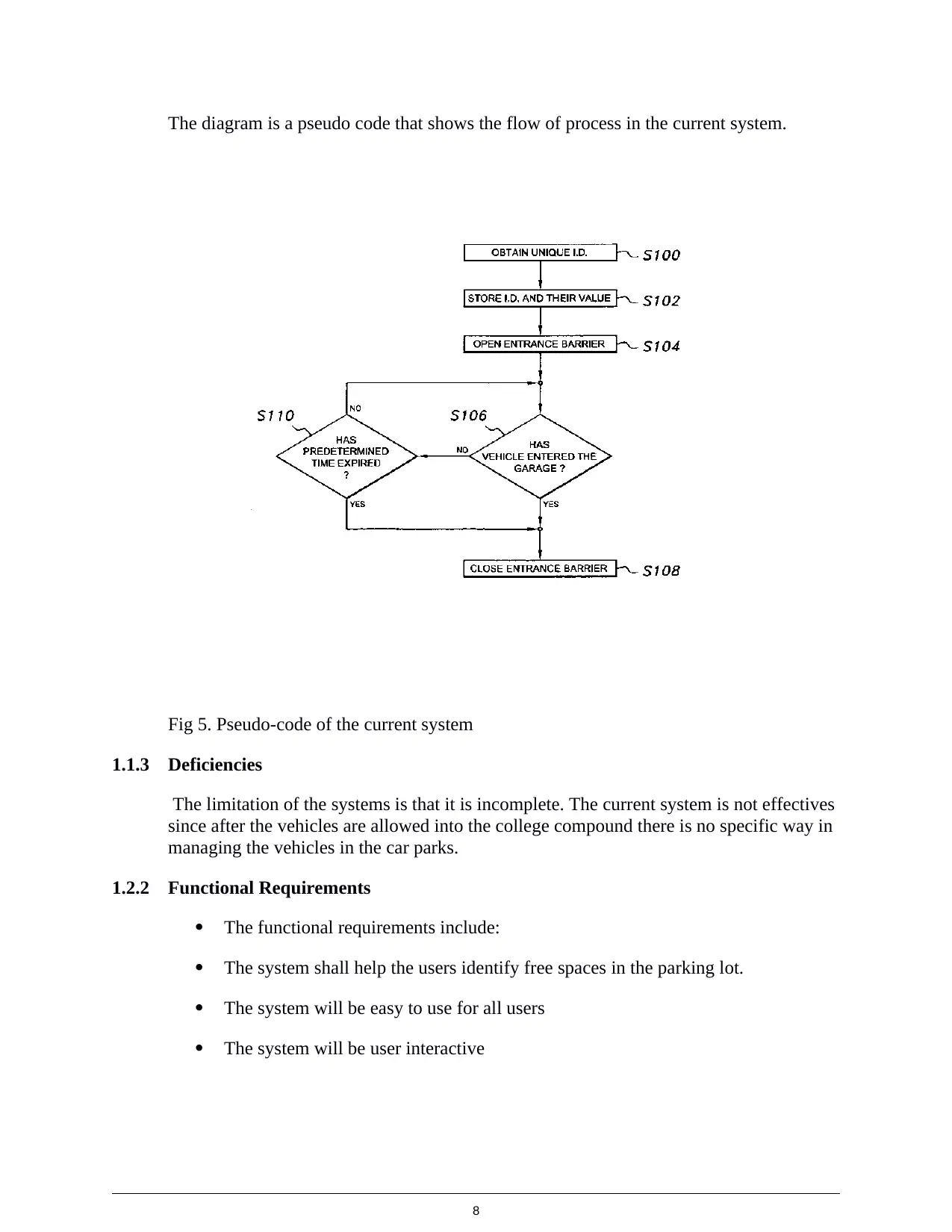
The diagram is a pseudo code that shows the flow of process in the current system.
Fig 5. Pseudo-code of the current system
1.1.3 Deficiencies
The limitation of the systems is that it is incomplete. The current system is not effectives
since after the vehicles are allowed into the college compound there is no specific way in
managing the vehicles in the car parks.
1.2.2 Functional Requirements
The functional requirements include:
The system shall help the users identify free spaces in the parking lot.
The system will be easy to use for all users
The system will be user interactive
8
Fig 5. Pseudo-code of the current system
1.1.3 Deficiencies
The limitation of the systems is that it is incomplete. The current system is not effectives
since after the vehicles are allowed into the college compound there is no specific way in
managing the vehicles in the car parks.
1.2.2 Functional Requirements
The functional requirements include:
The system shall help the users identify free spaces in the parking lot.
The system will be easy to use for all users
The system will be user interactive
8
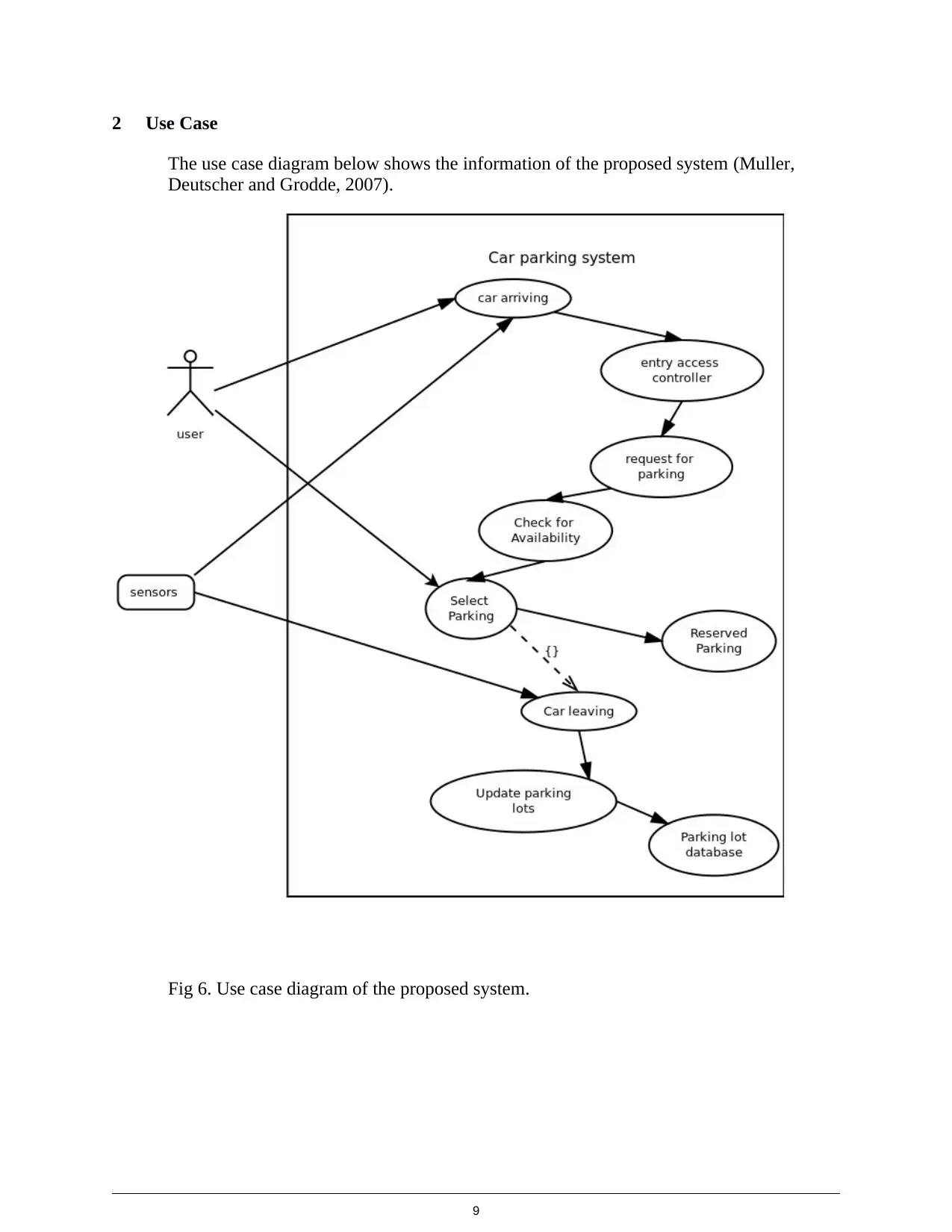
2 Use Case
The use case diagram below shows the information of the proposed system (Muller,
Deutscher and Grodde, 2007).
Fig 6. Use case diagram of the proposed system.
9
The use case diagram below shows the information of the proposed system (Muller,
Deutscher and Grodde, 2007).
Fig 6. Use case diagram of the proposed system.
9
⊘ This is a preview!⊘
Do you want full access?
Subscribe today to unlock all pages.

Trusted by 1+ million students worldwide
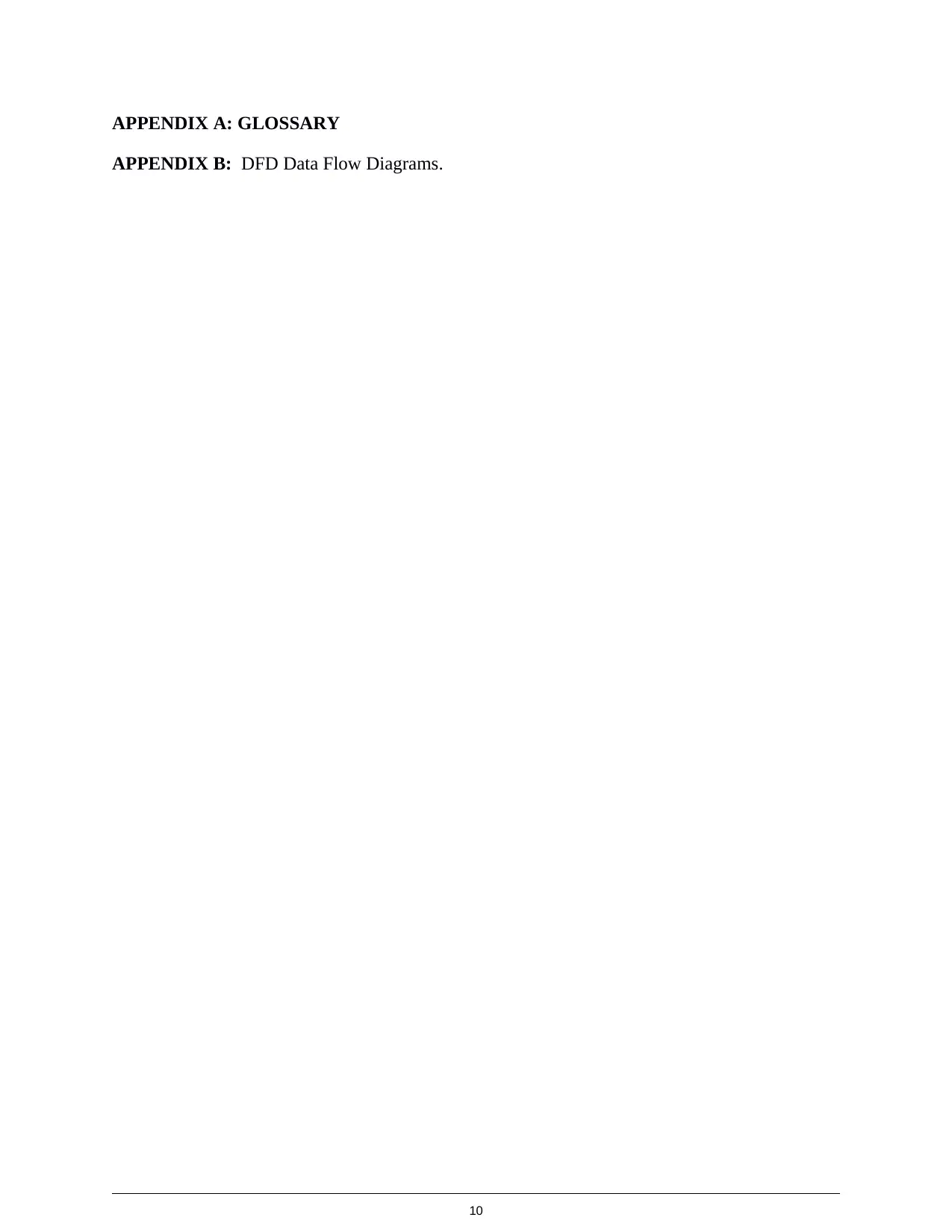
APPENDIX A: GLOSSARY
APPENDIX B: DFD Data Flow Diagrams.
10
APPENDIX B: DFD Data Flow Diagrams.
10
Paraphrase This Document
Need a fresh take? Get an instant paraphrase of this document with our AI Paraphraser

References
Zhdanov, A., Korolev, V. and Utemov, A. (2010). Adaptive control system for car parking.
Journal of Computer and Systems Sciences International, 49(3), pp.472-480.
Muller, B., Deutscher, J. and Grodde, S. (2007). Continuous Curvature Trajectory Design and
Feedforward Control for Parking a Car. IEEE Transactions on Control Systems Technology,
15(3), pp.541-553.
11
Zhdanov, A., Korolev, V. and Utemov, A. (2010). Adaptive control system for car parking.
Journal of Computer and Systems Sciences International, 49(3), pp.472-480.
Muller, B., Deutscher, J. and Grodde, S. (2007). Continuous Curvature Trajectory Design and
Feedforward Control for Parking a Car. IEEE Transactions on Control Systems Technology,
15(3), pp.541-553.
11

12
⊘ This is a preview!⊘
Do you want full access?
Subscribe today to unlock all pages.

Trusted by 1+ million students worldwide
1 out of 12